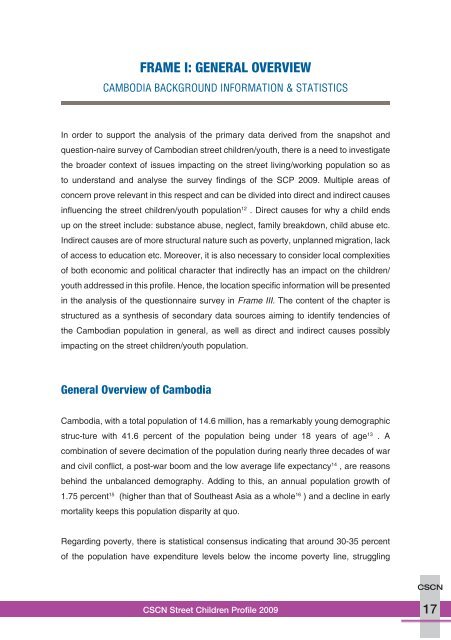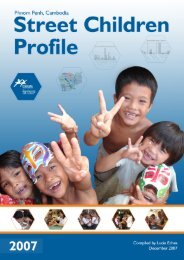Download - Friends International
Download - Friends International
Download - Friends International
Create successful ePaper yourself
Turn your PDF publications into a flip-book with our unique Google optimized e-Paper software.
FRAME I: GENERAL OVERVIEW<br />
CAMBODIA BACKGROUND INFORMATION & STATISTICS<br />
In order to support the analysis of the primary data derived from the snapshot and<br />
question-naire survey of Cambodian street children/youth, there is a need to investigate<br />
the broader context of issues impacting on the street living/working population so as<br />
to understand and analyse the survey findings of the SCP 2009. Multiple areas of<br />
concern prove relevant in this respect and can be divided into direct and indirect causes<br />
influencing the street children/youth population 12 . Direct causes for why a child ends<br />
up on the street include: substance abuse, neglect, family breakdown, child abuse etc.<br />
Indirect causes are of more structural nature such as poverty, unplanned migration, lack<br />
of access to education etc. Moreover, it is also necessary to consider local complexities<br />
of both economic and political character that indirectly has an impact on the children/<br />
youth addressed in this profile. Hence, the location specific information will be presented<br />
in the analysis of the questionnaire survey in Frame III. The content of the chapter is<br />
structured as a synthesis of secondary data sources aiming to identify tendencies of<br />
the Cambodian population in general, as well as direct and indirect causes possibly<br />
impacting on the street children/youth population.<br />
General Overview of Cambodia<br />
Cambodia, with a total population of 14.6 million, has a remarkably young demographic<br />
struc-ture with 41.6 percent of the population being under 18 years of age 13 . A<br />
combination of severe decimation of the population during nearly three decades of war<br />
and civil conflict, a post-war boom and the low average life expectancy 14 , are reasons<br />
behind the unbalanced demography. Adding to this, an annual population growth of<br />
1.75 percent 15 (higher than that of Southeast Asia as a whole 16 ) and a decline in early<br />
mortality keeps this population disparity at quo.<br />
Regarding poverty, there is statistical consensus indicating that around 30-35 percent<br />
of the population have expenditure levels below the income poverty line, struggling<br />
CSCN<br />
CSCN Street Children Profile 2009<br />
17






